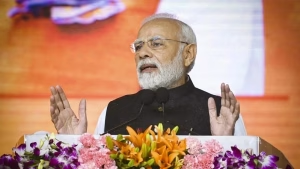Chhattisgarh – In a significant development in Chhattisgarh’s ongoing battle against insurgency, 50 Maoists surrender in Bijapur just days before Prime Minister Narendra Modi’s scheduled visit to the state. This establishment of 50 Maoists surrender in Bijapur marks a major milestone in counter-Maoist operations, reflecting the government’s success in weakening the insurgent influence in the region. The 50 Maoists surrender in Bijapur has gained attention worldwide as these rebels has been widely hailed as a step towards restoring peace and security in Chhattisgarh.
Details of the Surrender
The 50 Maoists, including several high-ranking cadres, laid down their arms before the police and security forces in Bijapur, a known Maoist stronghold. The surrendered rebels cited disillusionment with the movement, hardships within the organization, and the government’s rehabilitation programs as key reasons for their decision.

Authorities confirmed that the 50 Maoists surrendered in Bijapur voluntarily and expressed their willingness to reintegrate into society. Many of them were involved in violent attacks against security personnel and had active cases against them. Their decision to surrender is seen as a victory for security forces and a turning point in the region’s fight against insurgency.
Significance of the Surrender


The surrender of 50 Maoists in Bijapur is a major boost for counter-insurgency efforts in Chhattisgarh. It underscores the increasing pressure on Maoist groups due to intensified security operations, developmental initiatives, and targeted policies aimed at rehabilitating former rebels.
Bijapur has been a Maoist-affected district for decades, witnessing numerous encounters, ambushes, and violent clashes. The fact that 50 Maoists surrendered in Bijapur ahead of PM Modi’s visit sends a strong message about the declining influence of insurgents in the region.
Government’s Response and Rehabilitation Efforts
The Chhattisgarh government has reiterated its commitment to providing support and rehabilitation to surrendered Maoists. Under the state’s surrender policy, rebels who lay down arms are provided with financial assistance, skill development programs, and employment opportunities to reintegrate them into society.
Security officials stated that the 50 Maoists surrendered in Bijapur due to the government’s proactive measures, including increased deployment of security forces, better road connectivity, and welfare schemes aimed at winning the trust of tribal communities.
Security Measures Ahead of PM Modi’s Visit

With Prime Minister Narendra Modi set to visit Chhattisgarh soon, security has been heightened across the state, particularly in insurgency-affected areas. The 50 Maoists who surrendered in Bijapur were reportedly under surveillance, and their decision to give up arms has eased some security concerns.
Authorities have reinforced security arrangements to prevent any possible retaliation from remaining Maoist factions. The Prime Minister’s visit is expected to focus on developmental projects, infrastructure, and the government’s success in tackling extremism in the region.
Historical Context of Maoist Insurgency in Chhattisgarh
Chhattisgarh has long been a battleground between Maoist insurgents and security forces. The Bastar division, which includes Bijapur, has witnessed some of the deadliest Maoist attacks in India. Despite numerous crackdowns, the Maoist movement has persisted due to the dense forests, tribal support, and ideological motivations of the rebels.
However, the recent trend of surrenders, including the 50 Maoists who surrendered in Bijapur, indicates a shift in ground realities. Increased military action, better intelligence gathering, and the government’s development-centric approach have played a crucial role in weakening the insurgency.
Reactions from Political Leaders
The development of 50 Maoists surrender in Bijapur has drawn reactions from political leaders across the spectrum. Senior officials from the ruling party hailed the surrender as proof of the government’s success in curbing left-wing extremism.
Opposition leaders, while welcoming the development, urged the government to continue investing in social welfare programs to prevent further insurgency. They emphasized that addressing the root causes, such as poverty and lack of education, is key to ensuring lasting peace.
Impact on Local Communities
The development of 50 Maoists surrender in Bijapur has been met with mixed reactions from local communities. While many residents feel relieved that violence in their area may subside, others remain cautious about the possibility of retaliatory attacks from active Maoist groups.
Several families affected by Maoist violence have expressed hope that this surrender will lead to greater security in the region. Development initiatives such as schools, roads, and healthcare centers have been ramped up, aiming to integrate affected communities into the mainstream.
Also Read: Beed Mosque Blast 2025: Shocking Incident Causes Structural Damage
Experts’ Take on the Surrender
Security analysts view the establishment of 50 Maoists surrender in Bijapur as a crucial victory but warn against complacency. Experts argue that while these surrenders weaken the insurgency, the remaining Maoist factions could regroup and launch fresh attacks.
They also stress the importance of follow-up actions, including de-radicalization programs, psychological counseling, and job placements for surrendered rebels to prevent their return to militancy. The government’s continued focus on intelligence-based operations and engagement with tribal communities will determine the long-term success of counter-Maoist strategies.
Future of Counter-Maoist Operations
The establishment of of 50 Maoists surrender in Bijapur represents a significant step forward, but the fight against left-wing extremism is far from over. Security forces remain on high alert, and intelligence agencies are closely monitoring Maoist activities in neighboring regions.
With increased funding for road construction, mobile connectivity, and employment programs, the government aims to diminish the appeal of the Maoist ideology among vulnerable populations. The upcoming elections are also expected to play a role in shaping counter-insurgency policies, with political parties focusing on maintaining stability in conflict-prone areas.
Closing Remarks
The establishment of of 50 Maoists surrender in Bijapur ahead of Prime Minister Modi’s visit to Chhattisgarh marks a crucial moment in the state’s ongoing battle against insurgency. This development of 50 Maoists surrender in Bijapur signals a weakening Maoist influence and highlights the effectiveness of security measures and rehabilitation programs.
While this is a major victory of 50 Maoists surrender in Bijapur, the government and security agencies must remain vigilant to prevent any resurgence of insurgency. With continued efforts in infrastructure, education, and economic development, Chhattisgarh is moving closer to a future free from Maoist violence.

